What’s wrong with my boxwood? Boxwood pests and other threats
Have you noticed your boxwoods looking a little lackluster this season compared to previous years? Distinguishing the culprit responsible for your shabby shrubs is not always easy, but correct identification is key for management.

Boxwood (Buxus spp.) is a popular shrub in Michigan landscapes that is host to several insect pests including the boxwood leafminer, boxwood mite and boxwood psyllid. In addition to these pests, boxwoods are increasingly threatened by the new invasive box tree moth, diseases such as boxwood blight, and environmental stressors. Michigan State University Extension recommends considering the maintenance required for growing boxwoods and staying informed about emerging threats.
Boxwood leafminer
Boxwood leafminer, Monarthropalpusi flavus (Diptera: Cecidomyiidae), is one of the most common insect pests of boxwoods. This small fly is native to Europe and widely distributed throughout the United States. The leafminer can cause serious damage to boxwoods, and heavily damaged plants will become quite unattractive over time if no action is taken to decrease populations. The larvae feed between the upper and lower leaves, which causes blistering and discoloration.
Both littleleaf boxwood, B. microphylla and common boxwood, B. sempervivens, are commonly attacked, but some varieties of both species are resistant. Common boxwood cultivars with reported resistance are ‘Handworthiensis’, ‘Pyramidalis’, ‘Suffruticosa’ and ‘Varder Valley’. Buxus microphylla var. japonica has also exhibited resistance to the boxwood leafminer.
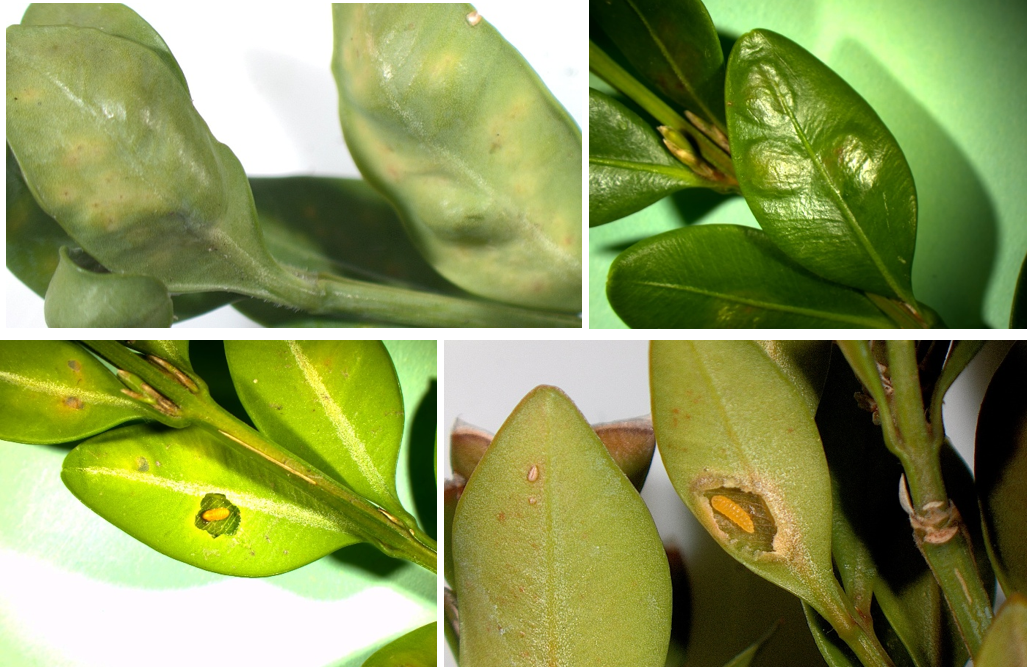
The larvae are yellowish-white and a little over 0.125 inches long. The adult boxwood leafminer is approximately 0.1 inches long, orange-yellow to red, and a gnat-like fly. The partially grown larvae over winter in their mines. The larvae grow rapidly as the weather begins to warm. In early to mid-May, they turn into orange pupae and emerge as a fly.
When weigelia begins to bloom, it’s time to start looking for boxwood leafminer activity. After mating, the female inserts her eggs deep into the leaf tissue and the eggs hatch approximately three weeks later. The larvae grow slowly as they eat away inside the leaf. In Michigan, there is a single generation each year.
If you are planning on planting boxwood, consider one of the previously mentioned varieties that are more resistant to leafminer damage. If you already have mature plants, pruning the foliage before adult emergence or after egglaying ends will help to reduce the overall population of adults.
Contact insecticides containing bifenthrin (Talstar), carbaryl (Sevin), cyfluthrin (Tempo or Bayer Advanced Garden Insect Control) or malathion are among the recommended materials for treating the adult flies. These are only effective if applied when adults emerge, which corresponds to when weigela is in bloom. Imidacloprid, a systemic insecticide (Merit or Bayer Tree and Shrub Insect Control), will control the larvae inside the leaves and does not require precise timing. This product should be applied in mid- to late April.
Boxwood mite
The boxwood mite, Eurytetranychus buxi, is a spider mite that feeds on the undersides of leaves and is difficult to see even with a hand lens. Infested leaves appear to be pin pricked or stippled with tiny white or yellow marks. The boxwood mite is a pest of both common and littleleaf boxwood varieties. Japanese boxwood is less susceptible. Applying high nitrogen fertilizers may lead to higher numbers of this mite.
Like most other spider mites that plague Michigan landscapes, the boxwood mite overwinters as eggs on the undersides of leaves. These eggs are greenish, round and flat-topped. They generally hatch in May and complete a generation in two to three weeks. Since multiple generations occur each year, it is important to apply control measures early in the season on plants that show high levels of the mite feeding injury.
This mite is more active in the spring and early summer. Adult mites are greenish brown. They may be found on the upper or lower surface of leaves. Heavy infestations may result in defoliation. Like other mite pests, infestations are often worse during dry, dusty conditions.
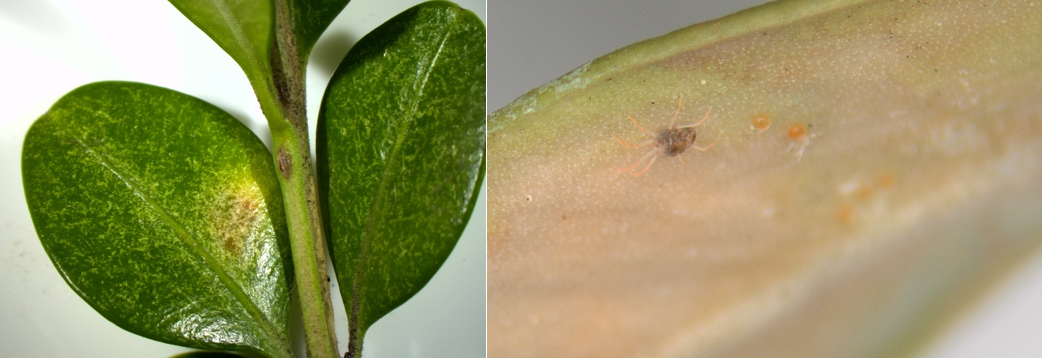
Controlling boxwood mites follows that of other spider mite pests. Try washing mites from the foliage with a stream of water. Summer rates of horticultural oil are also effective. A more aggressive approach includes treating with abamectin (Avid), bifenthrin (Talstar), malathion or oxythioquinox (Morestan) during the first two weeks in May.
Boxwood psyllid
The boxwood psyllid, Cacopsylla busi, is a less serious pest that occurs wherever boxwood is grown. It causes cupping of leaves and may affect twig growth, but the damage caused is purely aesthetic and not as destructive as other boxwood pests. The boxwood psyllid is a common pest of all boxwoods, but the American boxwood, Buxus sempervirens, is most susceptible.
This insect overwinters as a tiny, orange egg deposited in the bud scales. The eggs hatch in the spring when the buds of the host plant open. The nymphs immediately begin to feed and develop white, waxy strands over their bodies. Winged adults appear by early June. After mating, the female deposits her eggs between the bud scales of the host plant. There is one generation each year.
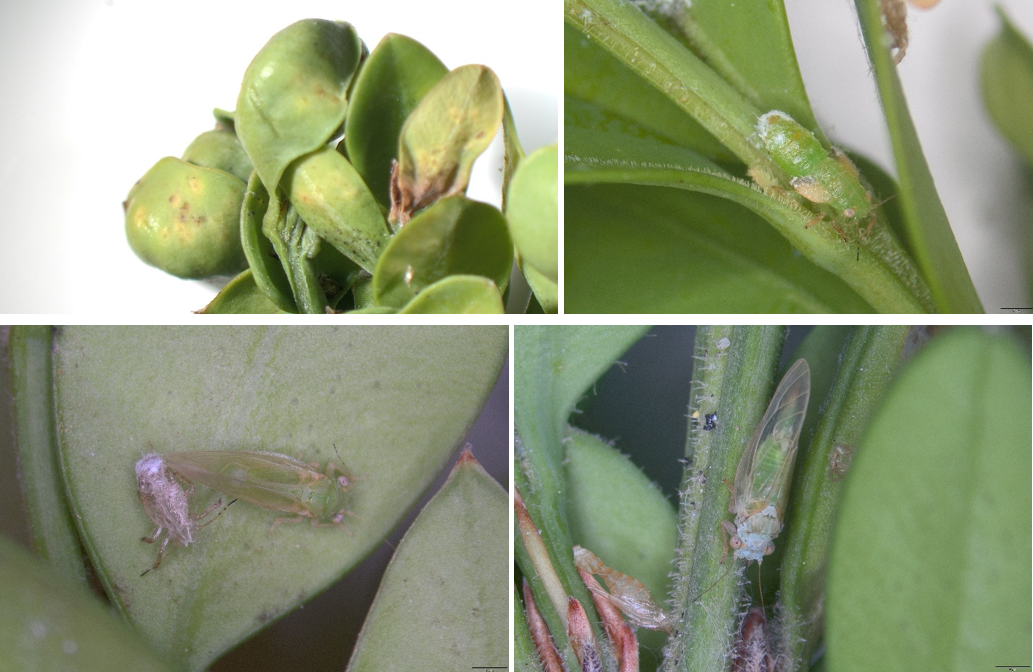
The nymph stage damages the host plant by feeding on newly developing foliage, causing the leaves to become cupped. This cupping conceals the psyllid and provides protection while feeding; however, the damage to the host plant is purely aesthetic.
This minor pest can be controlled by pruning off affected branch tips or with many of the insecticides mentioned above for other boxwood pests. An application should be made when young psyllids are present, in early May.
The new threat of box tree moth
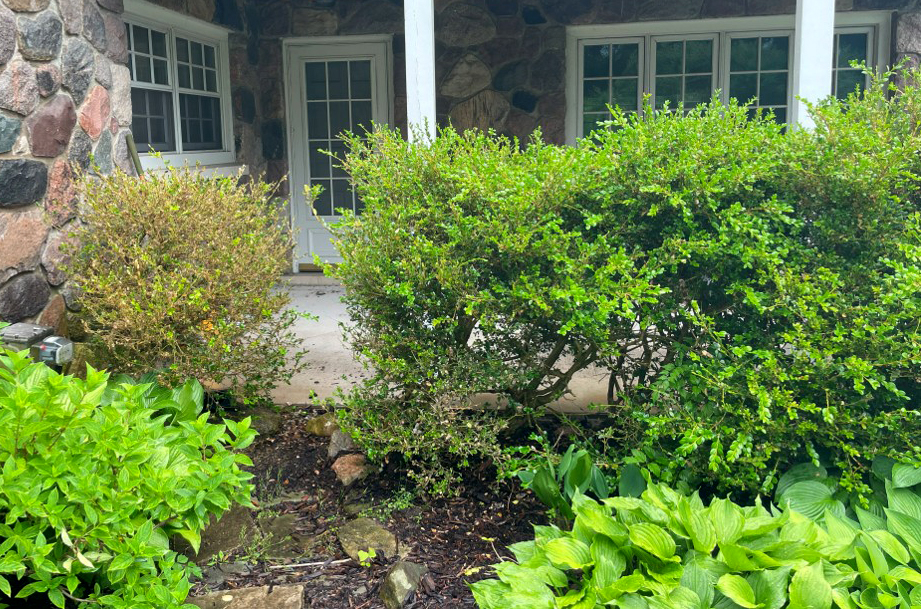
The box tree moth, Cydalima perspectalis, is an invasive pest that poses a significant threat to boxwood in Michigan. Native to East Asia, it has recently been detected in Michigan and is now regulated to help control its spread throughout the state. You can see the current quarantine zone where box tree moth is known to be present at the Michigan Department of Natural Resources Eyes in the Field website.
The moth goes through several life stages—egg, caterpillar, pupa and adult—with two to three generations per season. Caterpillars are the damaging stage, feeding aggressively on leaves, often leaving only the leaf midrib behind and causing a scorched appearance. In severe cases, they will feed on bark and can girdle stems. Defoliation and girdling can then lead to plant death.
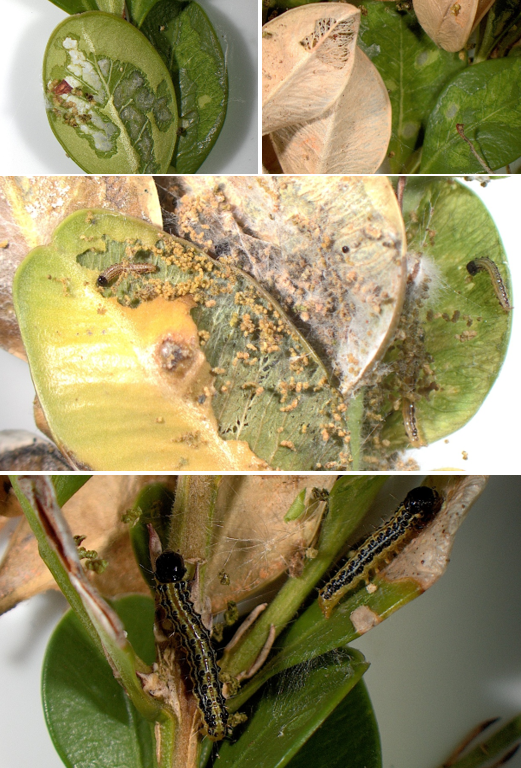
Adults are typically white with brown-bordered wings, though a rare all-brown morph also exists. Eggs are laid in jelly-like clusters on leaf undersides and hatch in about three days. Lime green caterpillars with black stripes, white spots, hairs and a shiny black head overwinter in silk webbing and can survive extreme cold. Pupation begins in spring and continues through fall. Because feeding can extend from early spring into October, overlapping generations can cause rapid and extensive damage if not managed. Early signs of infestation include webbing, frass (droppings) and browning foliage. Monitoring is essential, especially inside the plant canopy.
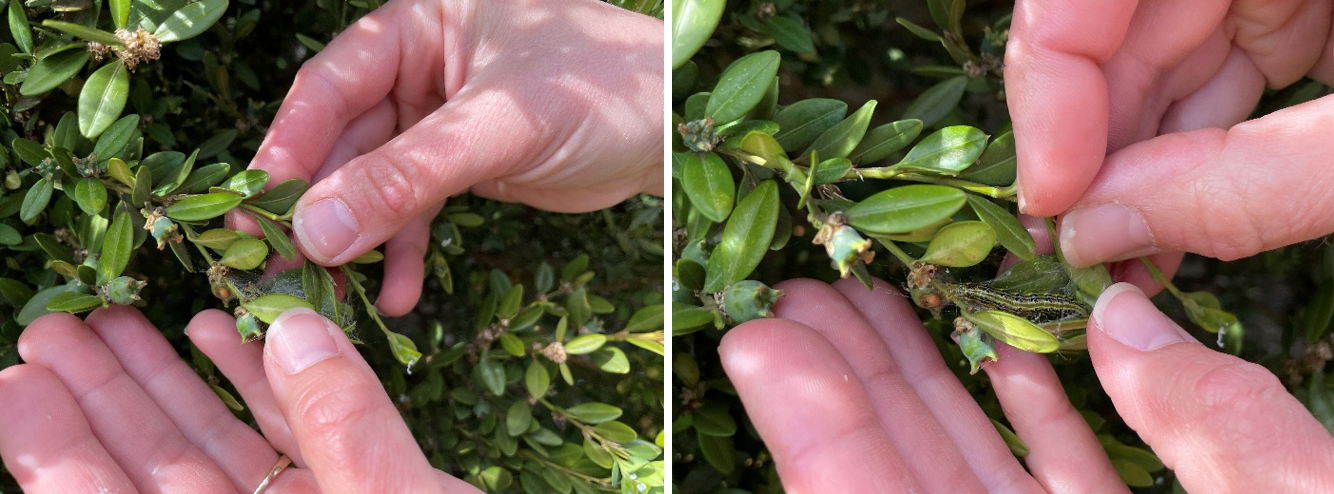
Management strategies include hand-picking larvae, removing leaf litter and maintaining plant health through proper pruning and watering. These methods are most effective in small gardens or early infestations. For heavier infestations, treatment with insecticides is recommended. For a list of treatment options, see the Ohio State University Extension publication, “Box Tree Moth: What Should You Do?” or contact Ask Extension.
Biorational and non-systemic chemistries such as horticultural oils, insecticidal soaps, Spinosad and Bacillus thuringiensis var. kurstaki (Btk) can be used, however they should be targeted at young caterpillar stages for effective control. Multiple applications will be necessary to target the multiple, overlapping generations of this pest.
Infested plant material should be double-bagged and disposed of in municipal waste—never composted or left for curbside pickup. Landscapers must follow quarantine rules when transporting Buxus spp. yard waste, ensuring it is enclosed and moved only to approved sites.
Box tree moth spreads naturally (3-6 miles per year) but can spread more quickly and widely through human activity, particularly via infested nursery stock or landscape plants. With vigilant monitoring, early intervention and responsible disposal practices, the spread of box tree moth can be slowed.
More resources regarding this pest are available at Michigan State University Extension’s Box Tree Moth website.
Could it be boxwood blight?
Boxwood blight, caused by the fungus Calonectria pseudonaviculata, is a serious disease affecting boxwoods and related plants like Pachysandra and Sarcococca. First reported in the United Kingdom in 1994, it has since spread across Europe, Asia and North America, including 28 U.S. states and parts of Canada. The disease causes rapid defoliation, stem lesions, plant decline and eventually death.
Both English boxwood, Buxus sempervirens ‘suffruticosa’, and American or common boxwood B. sempervirens are highly susceptible to boxwood blight. No species is fully resistant, and even partially resistant varieties can harbor the pathogen, sometimes contributing to its spread.
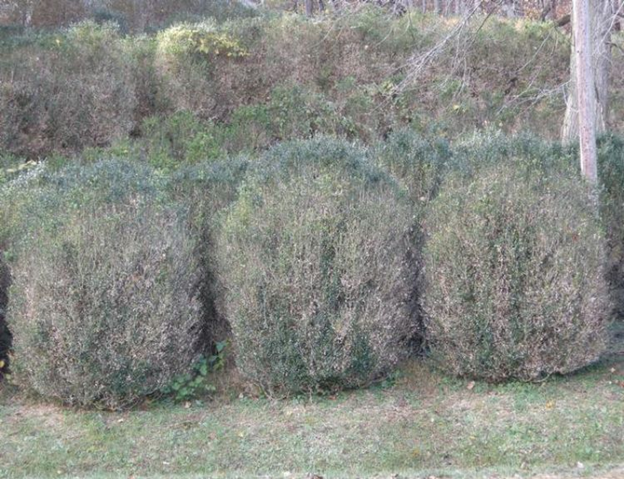
The fungus thrives in warm, humid conditions and spreads through sticky spores that cling to animals, tools, clothing and plant material. It can persist in soil and debris for up to five years due to durable resting structures called microsclerotia. Symptoms include leaf spots with dark borders, black stem streaks and a white, frosty appearance on leaf undersides during humid weather. Because symptoms can resemble other issues, proper diagnosis is essential and should be verified by sending plant samples to Michigan State University Plant & Pest Diagnostics.

Management strategies include purchasing plants from certified clean nurseries, quarantining new plants and practicing good sanitation. Being on the lookout for symptoms and removing infected material are key steps to prevent and slow the spread of this disease. Fungicides can help manage the disease, but they may also mask symptoms and lead to further infection later, making early detection and prevention critical.
See the Michigan State University Extension publication, “Boxwood blight disease identified in Michigan,” for more information.
When no pest or disease is present, the culprit could be environmental damage
Winter injury is the most common issue affecting boxwoods, especially in cold climates like Michigan. It typically appears as browning on the upper or outer leaves and stems once snow recedes, with green foliage remaining below the snowline. This damage is often caused by extreme cold (below -10 degrees Fahrenheit), especially in areas exposed to direct sunlight or near pavement. Fortunately, if the injury isn’t severe, affected areas can be pruned and plants often recover.
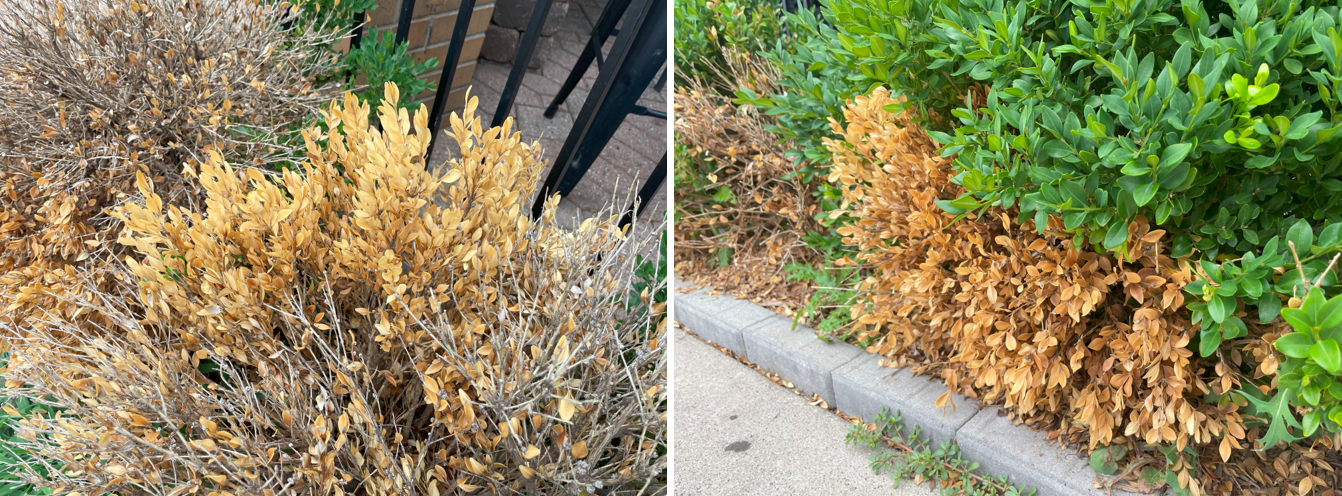
Other environmental stressors like salt damage and drought stress can also cause browning in boxwoods. Salt spray from roads or sidewalks can desiccate foliage, especially on the side facing the salt source, while salt buildup in soil can interfere with water uptake. Drought stress is most common in newly planted boxwoods or during extended dry periods and typically shows as browning in the center of leaves and yellowing foliage. Identifying the pattern and location of damage can help distinguish between these causes and guide appropriate care.
More information about environmental damage and other diseases impacting boxwoods can be found in the Michigan State University Extension article, “Browning of boxwood: Is it boxwood blight?”
Putting it all together—accessing threats to various boxwood varieties
Depending on where you live in Michigan and the conditions at your site, certain pests, diseases or environmental factors may be of more concern than others. It’s up to you to determine which threat will impact your boxwoods most critically. If you are in central or southeast Michigan, box tree moth will certainly be an important consideration as you care for boxwoods in your landscape. Use the table below to weigh out the value of certain boxwood varieties and their suitability for your site.
| Type of threat | Damage | Severity | Species impacted | Varieties known to be resistant | Management tips | Disposal |
|---|---|---|---|---|---|---|
| Boxwood leafminer, Monarthropalpusi flavus (Fly larva) |
Leaf blistering and browning | Can be severe when left untreated | Buxus sempervivens, B. microphylla | B. sempervivens ‘Handworthiensis’, ‘Pyramidalis’, ‘Suffruticosa’, ‘Varder Valley’; B. microphylla var. japonica | Prune foliage before adult emergence or after egg-laying ends to reduce populations | Composting or placing in yard waste is okay |
| Boxwood mite, Eurytetranychus buxi (Spider mite) | Leaves stippled with tiny white to yellow marks | Multiple generations per season can lead to defoliation, especially in hot dry weather | Buxus sempervivens, B. microphylla | B. microphylla var. japonica | Apply control measures in first two weeks of May for heavily infested plants; Avoid high Nitrogen fertilizers | Composting or placing in yard waste is okay |
| Boxwood psyllid, Cacopsylla busi (sap-feeding insect) |
Cupped leaves especially at branch tips | Purely aesthetic | All Buxus, but especially B. sempervivens | None | Prune off affected branch tips in early May | Home composting not recommended |
| Box tree moth, Cydalima perspectalis (Caterpillar) |
Leaf chewing, skeletonized leaves, browning, defoliation | Plant death can occur in as little as 2-3 seasons when left untreated | All Buxus | B. sinicia var. insularis (Korean boxwood), B. sinicia var. insularis x B. sempervirens hybrids *research is ongoing | Hand-pick small infestations; For heavy infestations, removal or treatment with insecticides are recommended | Double bag infested plants and debris and place in trash |
| Boxwood Blight, Calonectria pseudonaviculata (Fungus) | Rapid browning, defoliation, stem lesions and plant death | In warm, humid conditions complete defoliation can occur within days; persists in soil up to 5 years | All Buxus, especially B. sempervivens and B. sempervivens ‘Suffruticosa’; Pachysandra & Sarcococca | B. microphylla ‘Northern Emerald’, ‘Green Beauty’, ‘Peergold’ (Golden Dream); B. sinica var. insularis ‘Franklin’s Gem’, ‘Nana’, ‘Wee Willie’, ‘Wintergreen’, ‘Winter Gem’, ‘Eseles’ (Wedding Ring) | Purchase plants from certified clean nurseries, quarantine new plantings; Scout for symptoms, remove infected plants | Double bag infested plants and debris and place in trash |
| Environmental damage (winter injury, salt damage, drought stress) | Yellowing, reddened, or browning foliage | Can range from purely aesthetic to lethal | B. microphylla, B. sinicia var. insularis x B. sempervirens hybrids | B. sempervirens x B. microphylla var. koreana ‘Green Velvet’, B. sempervirens 'Suffruticosa’ x B. sinica var. insularis ‘Green Mountain’, Buxus sinica var. insularis ‘Wintergreen’ | Identify pattern and location of damage and take steps to provide cold or salt protection; provide irrigation to new plantings to avoid drought stress | No special considerations |
This work is supported by the Crop Protection and Pest Management Program [grant no 2024-70006-43569] from the USDA National Institute of Food and Agriculture. Any opinions, findings, conclusions, or recommendations expressed in this publication are those of the author(s) and do not necessarily reflect the view of the U.S. Department of Agriculture.



 Print
Print Email
Email

